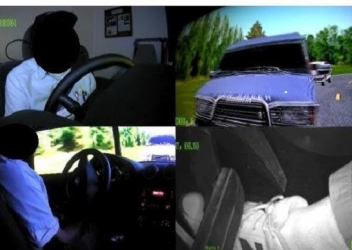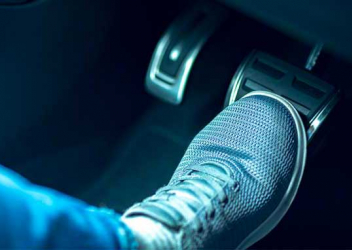Crash Avoidance and Autonomous Vehicles Research
CIRP researchers are studying how teens and other vulnerable populations interact with highly autonomous vehicles and use crash avoidance systems technologies to inform vehicle design and increase safety for drivers, passengers, and pedestrians. Current commercially-available vehicles are increasingly automated with Advanced Driver Assistance Systems (ADAS), including Forward Collision Warning and Lane Departure Warning, and automated features such as Automatic Emergency Braking.
As self-driving and semi-autonomous vehicle use continues to grow, our crash avoidance and autonomous vehicles researchers are also investigating new safety challenges for child passengers when riding in self-driving cars or autonomous vehicles. This crash avoidance and autonomous vehicles research is becoming increasingly important, especially regarding human factors.
The multidisciplinary research team utilizes CIRP’s driving simulators, which can emulate semi-autonomous and self-driving vehicles, to study the human factors at play when transitioning from one driving mode to the next in both day-to-day driving or in an emergency situation. Data analysis of the Strategic Highway Research Program 2 (SHPR2) Naturalistic Driving Study is allowing the team to investigate 1,500 real life crashes, many of them involving teens. In addition, the research team conducts qualitative research through focus groups and national surveys to assess the knowledge and comfort level of young drivers with ADAS and automated technologies.
Research Projects
- Effectiveness of Advanced Driver Assistance Systems (ADAS) Technologies
Efficacy of Automatic Emergency Braking Among Risky Drivers Using Counterfactual Simulations from the SHRP2 Naturalistic Driving Study
To determine the effect of Automatic Emergency Braking (AEB) to prevent or mitigate rear-end striking crashes, researchers deployed predictive analytics and modeling on the Strategic Highway Research Program 2 (SHRP2), a large naturalistic database They identified 97 rear-end striking crashes with drivers in four age groups: teens (ages 16-19); young adults (ages 20-24); adults (ages 35-54), and older adults (age 70+). The study found AEB to be very effective in preventing these crashes, preventing 57% involving teens, 81% involving young adults, 100% involving adults, and 71% involving older adults. However, they also found that AEB to be less effective in poor weather conditions and at higher speeds.
Read a blog post about the research
Principal Investigators: Thomas Seacrist, MBE; Helen Loeb, PhD
Funding: Center for Child Injury Prevention Studies (CChIPS).
- Novice Teen vs. Experienced Adult Drivers
Near Crash Characteristics Among Risky Drivers Using the SHRP2 Naturalistic Driving Study
Researchers analyzed 4,818 near crashes from the Strategic Highway Research Program 2 (SHRP2) naturalistic driving database involving four age groups: teen (ages 16-19), young adult (ages 20-24), adult (ages 35 to 54), and older adult (ages 70+). Their findings, published in the Journal of Safety Research, provide valuable insights into factors that can lead to crashes: teen and young adult drivers had a higher rate of near crashes than adults and older adults, with the most occurring in rear-end and road departure scenarios and there was a longer time-to-collision at braking during near crashes compared to crashes. This research can be used to develop more targeted driver training programs that focus on specific skill building and to help automobile manufacturers optimize ADAS technology to address the most common errors that can lead to crashes.
Read a blog post about the research
Principal Investigators: Thomas Seacrist, MBE; Helen Loeb, PhD
Funding: Center for Child Injury Prevention Studies (CChIPS)
Driving Analytics: Comparison of Teen and Adult Naturalistic Car-Following Patterns
This line of research uses the large-scale SHRP2 naturalistic driving database to compare crash rates between teen drivers ages 16 to 19 and experienced adult drivers ages 35 to 54. Scene videos were reviewed for all events to identify rear-end crashes and near-crashes, allowing the investigators to compare rear-end crash rates, crash severity, and impact velocity between novice teen drivers and experienced adult drivers. The results will help vehicle manufacturers design active safety systems to address the braking deficits of newly licensed teen drivers. Effectiveness of Advanced Driver Assistance Systems (ADAS) Technologies
Read a blog post about this line of research
Principal Investigators: Helen Loeb, PhD; Thomas Seacrist, MBE
Funding: Center for Child Injury Prevention Studies (CChIPS)
Emergency Autonomous to Manual Takeover in Driving Simulator: Teens vs. Adult Drivers
This study uses CIRP’s advanced driving simulator to safely introduce teen and adult drivers to driving in an autonomous vehicle and assess their ability to remain vigilant and promptly take over in the case of a failure of the autopilot. The project aims to understand how much driving experience is needed to safely take over from autopilot mode, as well as how the driver’s age influences the ability to sustain attention. This information can be used to better understand the human factors at play in self-driving technology.
Read the SAE Technical Paper abstract
Read a blog post about the research
Principal Investigator: Helen Loeb, PhD
Funding: Center for Child Injury Prevention Studies (CChIPS)
- User Perceptions of Autonomous Vehicles Technology
ADAS systems for teen drivers
A national survey was developed based on previous focus group research on active safety technology and teen drivers. The survey, given to 1,000 teens and 1,000 parents of licensed teens examined teen and parent perceptions of advanced driver assistance systems (ADAS) to help identify and overcome any potential barriers to ADAS use. Results, recently published in Traffic Injury Prevention and presented at the Association for the Advancement of Automotive Medicine (AAAM)'s 62nd Annual Conference, highlight potential barriers to ADAS use among teen drivers, including a relative disinterest among teens for ADAS intervention during risky driving and concerns among teens and parents that ADAS will inhibit skill development.
Read a blog post about the research
Principal Investigator: Thomas Seacrist, MBE
Funding: Center for Child Injury Prevention Studies (CChIPS)
Active Safety Technology
This project seeks to understand how teens and parents are responding to the advent of autonomous vehicles, particularly Advanced Driver Assistance System (ADAS) technologies, such as forward collision warnings, blind spot warnings, and lane keeping assist. Three teen focus groups and two parent focus groups were conducted to better understand perceptions about ADAS, if teens and parents are interested in using them, and what barriers might exist in their use. The findings of the focus groups were used to develop a national survey administered to 1,000 teens and 1,000 parents.
Read a blog post about the research
Principal Investigator: Thomas Seacrist, MBE
Funding: Center for Child Injury Prevention Studies (CChIPS); State Farm Mutual Automobile Insurance Company.
Ensuring Safety
This study seeks to understand the safety needs of children riding unaccompanied in self-driving vehicles. Many parents rely on services like Uber to bring their children, riding unaccompanied by a parent or caregiver, to afterschool activities or other functions. As self-driving cabs are now entering the roadways, the question about the proper age for a minor to be unaccompanied in a cab becomes more complex. This research will help inform specification of safety features, guidelines, and policies that will enable children to safely ride unaccompanied in self-driving vehicles.
Read the Children in Autonomous Vehicles Blue Ribbon Panel Report
Read a blog post about self-driving cars and traffic safety
Principal Investigator: Patrice Tremoulet, PhD
Funding: Center for Child Injury Prevention Studies (CChIPS)
- Virtual Driving Assessment
Virtual Driving Skills Assessment Research
Studies of newly-licensed teen drivers indicate that they exit the learner permit period with significant difficulty executing a variety of driving behaviors, leading to a three to four times increased risk of crashing the first year after getting licensed. CIRP researchers have developed and tested novel approaches to help teen drivers receive the necessary training to acquire skills and experience to drive safely. Research currently underway uses a validated Virtual Driving Assessment to dermine preparedness for safe driving prior to licensure and to provide feedback on critical skill deficits.
Principal Investigators: Flaura Winston, MD, PhD; Elizabeth Walshe, PhD
Funding: National Highway Traffic Safety Administration; State of Ohio; National Institute of Health (National Institute for Child Health and Development)










